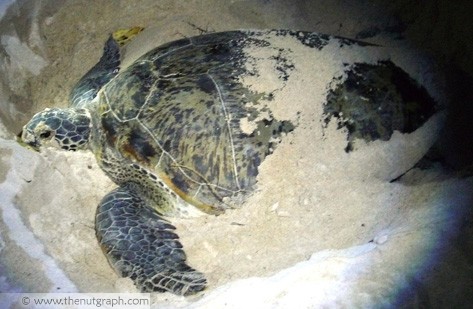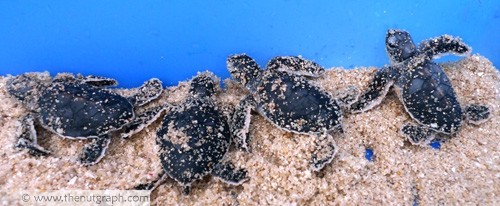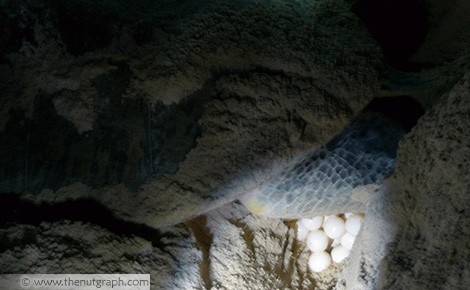WHEN a friend said he wanted a photo of himself riding on a sea turtle’s back, it made me flinch.
And yet, I doubt I would have winced had I not heard stories about how divers and snorkelers have disturbed and distressed turtles in the sea. If not for my marine-biologist friends, I probably would not have given this friend’s casual remark a second thought. After all, humans ride on horses, cows and elephants. So why not sea turtles, too?

Putting humans on top
This friend and I were volunteering on a turtle conservation project for a week at Chagar Hutang, Redang Island in September this year. What he wanted to do was ironic, considering that we were there to help conserve turtles that have been swimming in our seas since the age of the dinosaur.
Underlying his desire to ride a sea turtle is a worldview that seeks to dominate nature. It is a view that places humans above all other species, and regards other creatures as existing solely to satisfy human needs, desires and greed.
I do not blame my friend for holding a prevalent worldview that has been passed on by previous generations. But I am troubled by a paradigm that considers humans separate from nature, when it is impossible to divorce humans from the environment that sustains us.
Isn’t it precisely this sort of worldview that leads to human exploitation of nature and her beings on Earth? Indeed, the major environmental crises confronting our generation – climate change, biodiversity loss, and pollution, to name just a few – are a result of this problematic worldview.
People who continue to hunt hawksbill turtles for their exquisite shells, who sell or consume sea turtle eggs and meat, and who destroy turtles’ nesting beaches in the name of “development” all hold the same worldview.
And whether it’s by throwing plastic bags that end up choking sea turtles, buying from fisherfolk who use methods that kill marine turtles indiscriminately, or by simply being apathetic, we are guilty of threatening these ancient beings into extinction.
Sea turtles in Malaysia

Malaysia is blessed because four out of the seven living sea turtle species in the world can be found here. However, two of them – leatherback and olive ridley turtles – are effectively extinct in our country.
The leatherbacks, the largest among all, recorded over 10,000 annual nestings in Terengganu in the 1950s. However, over the past decade, the numbers have dwindled to just a handful. Once Terengganu’s star attraction, only one leatherback was reportedly seen in Rantau Abang this year.
As for the olive ridleys, nesting is only reported occasionally in Penang and Kelantan. None has been sighted in Terengganu since 2005. The numbers are probably insufficient to keep the population alive.
In comparison, hawksbill and green turtles are doing better. The Sabah Turtle Islands have the highest nesting concentration of hawksbill turtles in Southeast Asia, with an average of 500 to 600 annual nestings. Other nesting sites can also be found in Malacca and Terengganu.
Green turtles are the most widely distributed species in Malaysia. As with the leatherbacks, however, green turtle nesting has dropped dramatically since the 1950s, from 20,000 in the Sarawak Turtle Islands to a few thousand only in recent years. However, its population in the Sabah Turtle Islands has increased, and nestings in both Sabah and Terengganu also number in the thousands.
Changing our attitudes
Millions of ringgit have been spent to conserve our sea turtles during the past few decades. Turtle sanctuaries can now be found in Terengganu, Sabah and Sarawak.
However, The Star highlighted in a June 2010 report that laws relating to sea turtle conservation are still inconsistent and inadequate. The sale and consumption of turtle eggs, for example, have yet to be banned across all states. Additionally, turtle killings are allowed for a fee of RM100 in Johor, Kelantan and Negri Sembilan.
Conservation projects, educational campaigns. and strict laws regulating turtle conservation aside, what needs to change is the fundamental attitude humans hold towards other creatures.
As long as we continue to hold on to the worldview that treats nature as inferior and something to be dominated, we are unlikely to learn to respect it and its creatures, be it sea turtles, tigers or pandas. If we truly want to conserve the environment, our generation needs to re-learn that being top of the heap doesn’t mean those at the bottom can be exploited without repercussions for our species. ![]()
Gan Pei Ling has been wondering for a while if it is too much to ask members of the “superior” and “civilised” human species to learn to treat other Earthlings with respect and dignity.
The Nut Graph needs your support



Lola says
Read this – http://planetofthemonyets.blogspot.com/2010/09/turtles-screwed-again-this-time-at.html
Sulaiman Hood says
People who are supposed to be protecting the turtle are neglecting their responsibilities.
[…]
pelf @ Turtle Conservation Centre says
We started a “Say NO To Turtle Eggs” campaign in February 2008, and since then, have been spreading awareness of the plights of the sea turtles and collecting signatures from members of the public who pledge not to eat turtle (and terrapin) eggs for the rest of their lives.
Please support the campaign by signing the petition here:
http://www.ipetitions.com/petition/saveourturtles/
This may be a long and hard-to-fight battle, but together, we can do it 😀
ck chong says
I think the main problem is that humans always put themselves on the top of the pyramid.
lkl says
Who can say with certainty that the human species is not a freak of nature?
Jacqueline Ann Surin says
LOL.
Nazeri Abghani says
“Man dominate nature” … now I realise where all this desire to conquer peaks comes from – an innate flaw. It takes a bigger [person] to let nature dominate.